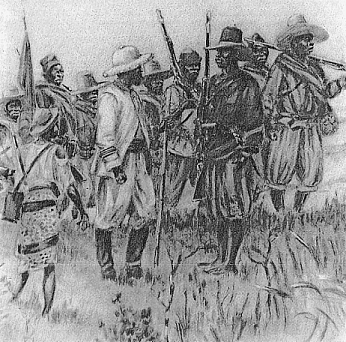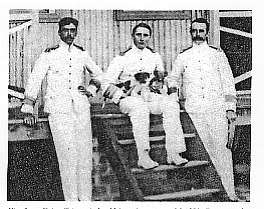"LA
FORCE PUBLIQUE" OR "DE OPENBARE WEERMACHT" IN THE
BELGIAN CONGO.
C.
Europeans' uniforms model 1903.
|
In
1903 the uniform for the European officers and NCO's was redesigned completely,
emphasizing the proper identity of the Force Publique. According to contemporary
documents it was "superbe sous tous les rapports" (outstanding)
and totally different from the civilian officials' uniforms.
Still no provision was made in relation
to the tropical climate. The existing officers' ranks remained, but the
new ranks
of "agent militaire" or "krijgsbeambte"
(military agent- two golden stripes and one silver) and "chef
comptable militaire" or "krijgshoofdrekenplichtige"
(military accountant - one golden stripe and two silver) were added in
1903, followed by "sous-officier" 1st (two golden stripes
and one in red wool) and 2nd class (one golden stripe and one in red wool).
The
full dress was a royal blue coloured dolman-type jacket with 6 braidings
and a straight collar with a golden star embroided on both left and right
front side. The tunic had one row of 6 buttons (guilded, embossed with
the Belgian Arms). Fig 4 shows the back of an officer's dolman ("galons
à la soubise", Fig 1). The collar of a Captain-Commandant's
jacket was decorated with a 2cm wide golden ribbon. On the cuffs (above
the rank stripes) a golden lion was embroided. The form of the shoulder
straps can also clearly be seen in Fig 1 (gold for officers, silver for
"agents militaire" and "chefs de comptable militaire"
and gold & red for "sous-officiers").
|
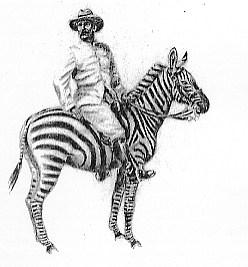 |
|
In
1903 Lieutenant Nijs attempted to break zebras to be used as mounts.
|
The pants were also in royal blue or white fabric; for Captain-Commandants with
a 2cm wide golden stripe. The headdress remained a white tropic helmet (with
a Belgian Arms metal insigna on the front) or a cap in royal blue with (above
the rank stripes) a embroided golden fivepointed star topped by the Royal Crown.
The
service dress differed little from the full dress, but in this case the dolman
could also be in white fabric instead of blue (Fig 2 & Fig 4). To make the
distinction between the service dress and the full dress, the shoulder straps
were made of yellow silk for officers, yellow goat's hair for "agents
militaire" and "chefs de comptable militaire" and
in mixed yellow and red wool for "sous-officiers".
The
sword tassel for officers was in guilded (full dress) or red leather (service
dress), for "agents militaire" in silver leather and for "chefs
de comptable militaire" in red leather. Although the uniform (apart
from some minor changes) remainded unchanged untill 1914, the rank stripes were
changed once more in 1911, not making things easier...
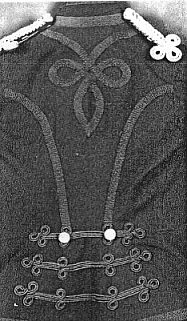 |
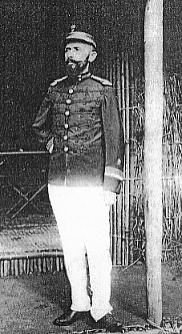 |
|
Fig
1 left): back view of the dolman 1903 full dress.
.Fig
2 (centre): Captain-Commandant 1st class Tombeur in 1903 service dress.
|
Fig
3 (top right): Force Publique in the north of the Congo
Fig
4 (bottom right): 3 officers in 1903 service dress. The officer in the
centre wears non-regulations white shoes (should be black).
|
|
RANKS 1889-1900
|
Sleeves
& cap
|
| Commandant
Captain-Commandant
1st class
Captain-Commandant 2nd class
Captain
Lieutenant
Second Lieutenant
Sous-Officier 1st Class
Sous-Officier 2nd Class
|
1 wide golden ribbon and 4 golden stripes
1 wide golden ribbon and 3 golden stripes
1 wide golden ribbon, 2 golden stripes and 1 silver stripe
1 wide golden ribbon and 2 golden stripes
1 wide golden ribbon and 1 golden stripe
3 golden stripes
2 golden stripes
1 golden stripe
|
|
RANKS 1911
|
Sleeves
& cap
|
| Colonel
Lieutenant-Colonel
Major (*)
Captain
Lieutenant and lieutenant-chef
comptable
Second Lieutenant and sous-lieutenant-chef
comptable
agent
militaire and chef
de comptable militaire
Sous-Officier 1st Class
Sous-Officier 2nd Class
|
1 wide golden ribbon and 4 golden stripes
1 wide golden ribbon, 3 golden stripes and 1 silver stripe
1 wide golden ribbon and 3 golden stripes
1 wide golden ribbon, 2 golden stripes and 1 silver stripe
1 wide golden ribbon and 2 golden stripes
1 wide golden ribbon, 1 golden stripe and 1 silver stripe
3 golden stripes
2 golden stripes and 1 silver stripe
1 golden stripe and 2 silver stripes
|
(*)
On 25th June 1912 it was ordered that a Major would have 1 golden ribbon, 2 golden
stripes and 2 silver stripes and a Captain-Commandant 1 golden ribbon and 3golden
stripes. The inverse would have been more logical...



